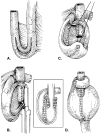Clinical aspects of continent ileostomies
- PMID: 20011285
- PMCID: PMC2780079
- DOI: 10.1055/s-2004-823071
Clinical aspects of continent ileostomies
Abstract
Continent ileostomy (Kock pouch) is an alternative to end ileostomy for patients who have undergone total proctocolectomy. The procedure reached the height of its popularity soon after its introduction in 1969, but subsequently was supplanted by ileal pouch-anal anastomosis (IPAA), an operation that preserves the natural route of defecation. Continent ileostomy is still appropriate for selected patients with ulcerative colitis and familial polyposis who are not candidates for IPAA or for whom IPAA or end ileostomy have failed. Complication rates that initially were high have decreased during the past three decades following the steady introduction of technical improvements.
Keywords: Continent ileostomy; Kock pouch; review; technique.
Figures



Similar articles
-
Continent ileostomy: current status.Clin Colon Rectal Surg. 2008 Feb;21(1):62-70. doi: 10.1055/s-2008-1055323. Clin Colon Rectal Surg. 2008. PMID: 20011398 Free PMC article.
-
Quality of life after proctocolectomy. A comparison of Brooke ileostomy, Kock pouch, and ileal pouch-anal anastomosis.Gastroenterology. 1991 Sep;101(3):679-84. Gastroenterology. 1991. PMID: 1650316
-
Construction of and Conversion to Continent Ileostomy: A Systematic Review.Dis Colon Rectum. 2022 Dec 1;65(S1):S26-S36. doi: 10.1097/DCR.0000000000002631. Epub 2022 Sep 23. Dis Colon Rectum. 2022. PMID: 36165572
-
Long-term Follow-up, Patient Satisfaction, and Quality of Life for Patients With Kock's Continent Ileostomy.Dis Colon Rectum. 2021 Apr 1;64(4):420-428. doi: 10.1097/DCR.0000000000001823. Dis Colon Rectum. 2021. PMID: 33315706
-
Don't Forget about the K-Pouch!Clin Colon Rectal Surg. 2022 Nov 29;35(6):499-504. doi: 10.1055/s-0042-1758192. eCollection 2022 Nov. Clin Colon Rectal Surg. 2022. PMID: 36591399 Free PMC article. Review.
Cited by
-
Continent ileostomy: current status.Clin Colon Rectal Surg. 2008 Feb;21(1):62-70. doi: 10.1055/s-2008-1055323. Clin Colon Rectal Surg. 2008. PMID: 20011398 Free PMC article.
References
-
- Kock N G. Intra-abdominal “reservoir” in patients with permanent ileostomy: preliminary observations on a procedure resulting in fecal “continence” in five ileostomy patients. Arch Surg. 1969;99:223–231. - PubMed
-
- Wu J S, Fazio V W. Continent ileostomy: evolution of design. Clin Colon Rectal Surg. 2002;15:231–243.
-
- Beahrs O H. Use of ileal reservoir following proctocolectomy. Surg Gynecol Obstet. 1975;141:363–366. - PubMed
-
- Goldman S L, Rombeau J L. The continent ileostomy: a collective review. Dis Colon Rectum. 1978;21:594–599. - PubMed
-
- Schrock T R. Complications of continent ileostomy. Am J Surg. 1979;138:162–169. - PubMed
LinkOut - more resources
Full Text Sources
Miscellaneous

